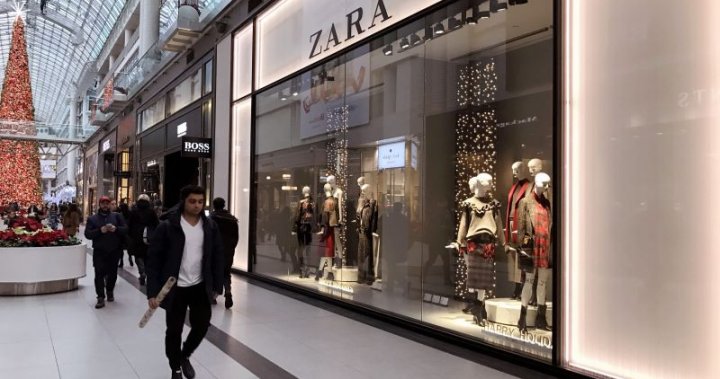Lisa Simmons is used to helping customers check off their Christmas lists at her women’s clothing store during the holiday season, but she says this year has been far less busy than usual.
Simmons is the owner of Lemonberry in Aurora, Ont., which has been in business for over 20 years. She describes the store as eco-conscious, with local manufacturing and sustainability at the front of mind.
“Unfortunately, I actually find it more challenging this year than I did during COVID,” Simmons told Global News.
She says she’s always had customers who are knowledgeable about sustainable shopping and who value purchasing quality over quantity. While they still come by, she says the volume of customers who have been coming through her door this holiday season is not the same.
“I guess it’s a sign of the times,” she said.
Multiple studies have shown that Canadians are planning on keeping a tight budget this holiday season due to the skyrocketing cost of living. Retail analyst Bruce Winder says it could mean shoppers swap their sustainable shopping plans for more cost-friendly deals.
Fast-fashion retailers in particular will likely find it easier this season than in years past to reel in Canadians aiming to tighten their purse strings, Winder says.
He says consumers may feel as though they have no choice than to shop at less sustainable companies in order to find the lowest prices possible and stay within their budget.
“Where we are right now, if you look at the economics, interest rates… they haven’t kept up with the cost of living over the last 30 years,” Winder told Global News.
“I think that consumers… feel they are being forced to buy from companies that may not put the environment first.”
A recent Ipsos poll conducted exclusively for Global News found Canadians were planning to pull back on holiday spending this year, with nearly 80 per cent saying inflation and rising rates had a “significant” impact on their holiday budget.
And a recent NerdWallet survey conducted in October found that nearly half of Canadians who plan to purchase gifts this holiday season (48 per cent) have a strict budget for the amount they will spend. Thirty-five per cent of holiday shoppers plan to shell out less per person this year compared to years past, the results showed.
Despite shoppers’ best intentions, Winder says he predicts fast-fast fashion stores will win over consumers this holiday season with their extra low prices and deals.
“I think that consumers are kind of going through that struggle right now and they’re probably erring on the side of buying from the offshore players, the fast-fast fashion players, because they feel they have to at this point,” he said.
The difference between fast-fashion brands such as Zara and H&M, and fast-fast fashion companies like SHEIN is simply the timeline, he says. H&M is able to distribute a new design in a few weeks, while stores like SHEIN, known for its inexpensive and on-trend clothing, can start shipping out small quantities in days.
The ultra-mass manufacturing allows fast-fast fashion brands to keep their prices extra low, which is enticing for consumers looking to stay within budget. But Winder says a spike in demand this winter will come at a cost to the environment.
“It’s great from a consumer response standpoint, but is buying more fashion the best thing for us right now on the planet? We can see… the floods, how hot it is in certain areas, crop yields going down, all kinds of weather issues that’ll have real consequences on us,” he said.
SHEIN was valued at more than US$60 billion in a $2 billion private fundraising round in March, outpacing fashion giants Zara and H&M.
The company, based in Singapore, confidentially filed to go public in the United States in November, according to reporting from Reuters and other news outlets.
Winder says the reported IPO filing shows that fast fashion is growing “like never before.”
“It shows that consumers, young consumers, are embracing them even though there’s allegations in terms of like… not being the top quartile in terms of environmental protection, that it doesn’t matter almost,” he said.
A study from the University of Waterloo published in January found that Canadians toss away close to 500 million kilograms of fabric items on a yearly basis, including such things as clothing, shoes and toys.
Professor Olaf Weber, who co-authored the study, said that fashion consumption is at an “unparalleled high.”
“Consumers buy, use and dispose of new garments, which end up in the landfill, and less than one per cent of the materials are recycled,” he said in an interview with Global News in January.
Over the holidays, Zero Waste Canada estimates that 545,000 tonnes of waste is produced by Canadians each year from gift wrapping and shopping bags alone.
Winder says that despite the overall spike in fast-fashion consumption that may occur this winter, one demographic has shown promising shopping habits in recent years: young adults.
“Millennials and Gen Z, they’re more environmentally conscious than maybe some of the Gen Xers and Boomers,” he said.
Young people have made a trend out of thrift shopping, he says, which will be beneficial during the holiday spending season.
A survey by Sharethrough conducted in September supports Winder’s prediction.
It found that younger generations, particularly Generation Z, showed the greatest interest (38 per cent) in buying from sustainable brands this season.
Younger generations, in particular Generation Z (18-24), showed the greatest interest with 38 per cent saying they are very likely to buy from sustainable brands.
However, Winder says the financial pinch felt across demographics remains a problem, meaning young people will likely still have to make some “tough choices.”
Back at Lemonberry, Simmons says she appreciates that customers are making a continuous effort to shop sustainably, whether they can financially swing it or not.
She says many consumers aren’t actually aware that they are saving money by purchasing high quality, long-lasting clothing.
“When you’re looking, I feel like you need to be more mindful,” she said.
“Maybe your budget is shorter now, (and) most of us are in that boat I think, (but) buy something that’s better quality and that’s going to last.”
— with files from Global News’ Kevin Nielson.




